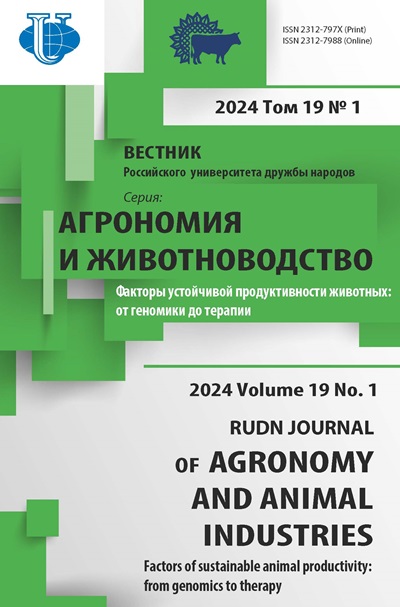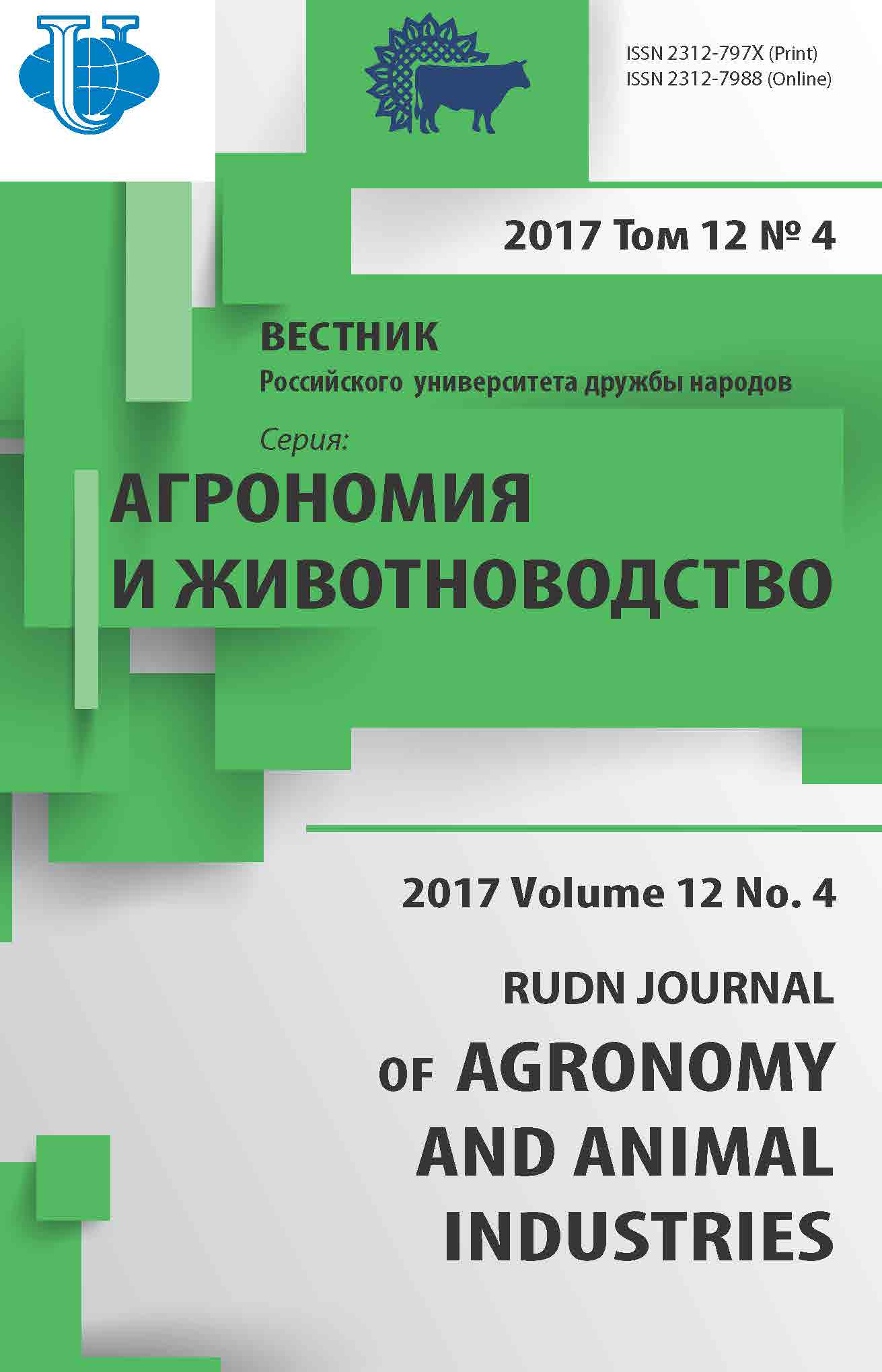INFLUENCE OF SOIL AND MINERAL FOOD PROCESSING ON THE DYNAMICS OF BIOLOGICAL ACTIVITY AND NPK IN COLD YARNS
- Authors: Mikitin SV1, Shuravilin AV1, Borodychev VV2, Novikov AE3,4
-
Affiliations:
- Peoples’ Friendship University of Russia (RUDN University)
- All-Russian Scientific Research Institute of Hydraulic Engineering and Melioration named after A.N. Kostyakov Str
- All-Russian Research Institute of Irrigated Agriculture
- Volgograd State Technical University
- Issue: Vol 12, No 4 (2017)
- Pages: 295-304
- Section: Articles
- URL: https://agrojournal.rudn.ru/agronomy/article/view/17472
- DOI: https://doi.org/10.22363/2312-797X-2017-12-4-295-304
Cite item
Full Text
Abstract
The use of scientifically based doses of fertilizers in the cultivation of crops does not lead to the removal of nutrients from the natural reserves of the organic and mineral soil by microflora. At the same time, the methods and terms for the introduction of mineral fertilizers must be linked with the technology of soil preparation and moisture supply. Nitrogen fertilizers, because of their rapid volati-lization, are recommended to be applied for pre-sowing cultivation with sealing in the surface layer, and phosphorous fertilizers, as inactive - along with the main soil treatment. In this connection, in studies of the significant influence of the methods of basic soil cultivation with and without application of nitrogen, its dynamics along layers are not revealed. Deep soil-free tillage allows significantly more accumulation and longer storage of moisture in the soil layers; In comparison with the classical plowing and dumping plowing and planing in a meter layer of soil, the additional moisture reserves before sowing the crop are respectively 300 and 230 m3 / ha, in the tubing phase - barley - 256 and 189 m3/ha, in the phase of milk ripeness - 270 And 128 m3/ha. Deficiency of moisture reduces the biological activity of the soil, in this regard, moisture-saving methods of basic soil cultivation are especially important in conditions of rain-fed farming, not only on the yield of agricultural crops, but also on the processes of humus formation. The total accumulation of amino acids in the half-meter layer in the variant with deep soil-free tillage before sowing barley was 424 μg amine / G of cloth, in the phase of tubing - ear - 400 μg amine / G canvas, in the phase of milk ripeness - 210 μg amine / G of canvas. The values obtained are higher in comparison with the control data and the variant with planar tillage at 7 and 18%, 48 and 32%, 10 and 36% respectively. Positive dynamics in terms of productive moisture and accumulation of amino acids in the variant with deep soil-free soil treatment, application of calculated phosphorus doses for main processing and nitrogen for pre-sowing cultivation, had an effect on a significant increase in grain relative to control at 0.4 t/ha, Processing - at 0.35 t/ha.
About the authors
S V Mikitin
Peoples’ Friendship University of Russia (RUDN University)
Author for correspondence.
Email: stanislavpiven@mail.ru
Микитин Станислав Владимирович - аспирант агроинженерного департамента Аграрно-технологического института Российского университета дружбы народов
Miklukho-Maklaya st., 6, Moscow, Russia, 117198A V Shuravilin
Peoples’ Friendship University of Russia (RUDN University)
Email: stanislavpiven@mail.ru
Шуравилин Анатолий Васильевич - доктор сельскохозяйственных наук, профессор Аграрно-технологического института Российского университета дружбы народов
Miklukho-Maklaya st., 6, Moscow, Russia, 117198V V Borodychev
All-Russian Scientific Research Institute of Hydraulic Engineering and Melioration named after A.N. Kostyakov Str
Email: stanislavpiven@mail.ru
Бородычёв Виктор Владимирович - доктор сельскохозяйственных наук, профессор, академик РАН, директор Волгоградского филиала ГНУ ВНИИГиМ
Bolshaya Akademicheskaya st., 44/2, Moscow, Russia, 127550A E Novikov
All-Russian Research Institute of Irrigated Agriculture; Volgograd State Technical University
Email: stanislavpiven@mail.ru
Новиков Анатолий Евгеньевич - доктор сельскохозяйственных наук, главный научный сотрудник всероссийского ВНИИ орошаемого земледелия, Волгоградского государственного технического университета
Named after Timiryazev st., 9, Volgograd, Russia, 400002; Named after Lenin ave., 28, Volgograd, Russia, 400005References
- Gordeev, A.V., Romanenko, G.A. The problem of degradation and restoration of agricultural land productivity in Russia. Moscow: Rosinformagrotekh, 2008. 67 p.
- Kozina, G.N. Microbiological activity as one of the factors regulating the yield of barley. Agrarian Bulletin of the Urals. 2008. № 2. P. 64—66.
- Pindak, V.I., Novikov, A.E. Agrotechnical land reclamation in arid conditions of the Lower Volga Region. Agricultural machines and technologies. 2013. № 4. C. 15—17.
- Shuravilin, A.V., Borodychev, V.V., Novikov A.E., Poddubsky A.A. Yield of spring barley on chestnut soil of the Lower Volga Region. RUDN Journal of Agronomy and Animal Industries. 2016. № 2. C. 7—14.
- Armor, B.A. Methodology of field experience (with the basics of statistical processing of research results). Moscow: Agropromizdat, 1985. 351 p.
- Zvyagintsev, D.G. Methods of soil microbiology and biochemistry. Moscow: MSU, 1980. 224 p.
- Mishustin, E.N., Petrova, A.N. Determination of soil biological activity. Microbiology. 1963. Vol. 32. Issue. 3. P. 479—483.
- GOST 26205-91. Soil. Determination of mobile compounds of phosphorus and potassium by the method of Machigin in the modification of CINAO. Instead of GOST 26205-84; Enter. 07/01/1993. Moscow: Izd-vo standards, 1992. 8 p.
- GOST 26488-85. Soil. Determination of nitrates by the method of CINAO. Enter. 07/01/1986. Moscow: Publishing Standards, 1985. P. 34—37.
- Misyryaev, V.Yu. Influence of the main processing of light chestnut soil on the yield of spring barley Yergeninsky 2. News of the Nizhnevolzhsky agro-university complex: science and higher vocational education. 2013. T. 1. No. 2-1 (30). Pp. 72—75.
- Pleskachev, Yu.N., Borisenko, I.B., Misyryaev, V.Yu., Koscheev, I.A. Innovative methods of soil treatment in the cultivation of barley. Fertility. 2012. № 6. P. 18.
- Skorykov, V.T., Shuravilin, A.V., Ziadin Diya Sami, Borodychev, V.V. Studying the ways of soil cultivation during the cultivation of spring wheat in arid conditions of Jordan. Agriculture. 2010. № 5. C. 17—18.
- Kuznetsov, P.I., Novikov, A.E. Influence of the treatment method on the water-physical properties of irrigated light-chestnut soils. Melioration and water management. 2009. № 2. C. 37—39.
















